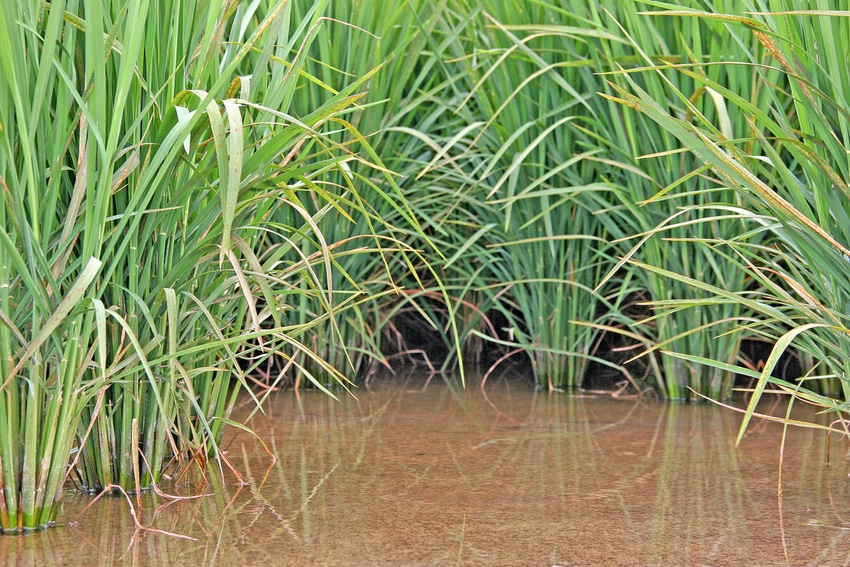March 25, 2016

Disease management starts long before going to the field to plant rice.
(1) Match variety with field: To maximize productivity with minimum risk, knowing the history of your field and using the right variety for the field is essential. Often this may mean planting more than one or two varieties on multiple farms.
Hybrids have the best resistance to diseases such as rice blast, bacterial panicle blight, and sheath blight. Hybrids would be good candidates in fields with histories of such diseases. Note that hybrids are not immune to these diseases but can be more tolerant.
However, they are more susceptible to kernel smut and false smut. If hybrids are planted in fields with a history of the smuts, cultural management options need to be strictly followed to reduce their incidence and severity.
(2) Balance nutrients: Soil fertility plays a major role in disease severity. Application of excessive nitrogen strongly favors the smuts, sheath blight, blast, and bacterial panicle blight diseases of rice, among others. Potassium has shown to reduce the severity of some major rice diseases including brown spot, stem rot and likely reduces the severity of bacterial panicle blight and sheath blight, among others.
Balancing N-P-K (nitrogen-phosphorus-potassium) to increase productivity by increasing the defense system (tolerance) of the crop to diseases is always a good strategy.
(3) Minimize risk with planting dates: Early planting is often recommended to reduce or escape the late-season diseases that include blast, bacterial panicle blight, and narrow brown leaf spot and smuts, especially false smut. However, we may also reduce environmental or weather risks by spreading out planting dates.
(4) Reduce risk by proper water management: Effective water management reduces drought stress, which in turn reduces stress-related diseases such as blast and panicle blanking. Drought stress associated with sandy soils and poor irrigation management predispose rice plants to infection by the blast pathogen.
On the other hand, drought stress by itself results in blank panicles that can be confused with bacterial panicle blight. Therefore, it is important to know the capacity of your water sources to determine how much of your field can be effectively irrigated without creating stress on your rice.
More
(5) Reduce rice problems by drain and dry strategy: If a field is known to have a straighthead problem, variety selection for resistance is highly recommended.
Read more on variety reactions.
In addition, you need to follow the “drain and dry” strategy to effectively minimize yield loss from straighthead. Draining and drying are often done before mid-season nitrogen application based on your DD 50 schedule. Likewise, hydrogen sulfide toxicity, also referred to autumn decline or akiochi, needs draining and drying for fields with history or for new fields showing severe symptoms.
Timing of draining a field to correct hydrogen sulfide toxicity is similar to the recommendation for straighthead. However, extra caution may be needed for recurring hydrogen sulfide toxicity problem or for incidences that may occur late in the rice developmental stages.
(6) Reduce rice field problems by managing field sizes: In fields with straighthead or hydrogen sulfide toxicity, the smaller the field size, the easier it should be to drain and dry followed by re-flooding of the field.
(7) Use fungicides properly: Both seed treatment and foliage fungicide application can be beneficial in well-managed fields. Fungicides for rice diseases may not render the intended results in fields where early-season nitrogen is excessive, potassium is low, and irrigation is inadequate.
Timing and rates of fungicides are majorly important to benefit from fungicide application.
Unless used as a protective application for diseases such as blast, kernel smut, and false smut, fungicides are not encouraged for use on resistant varieties or in the absence of disease occurrence on rice plants.
It is likely for the pathogens to develop resistance if fungicides are not used properly for the right purpose.
Fungicides are not recommended for problems such as straighthead, hydrogen sulfide toxicity or bacterial diseases, for example bacterial panicle blight.
As a best practice, scout for diseases.
Yeshi Wamishe is the Extension Rice Pathologist for the University of Arkansas Division of Agriculture. Email him at [email protected].
You May Also Like




